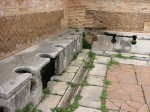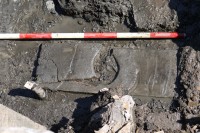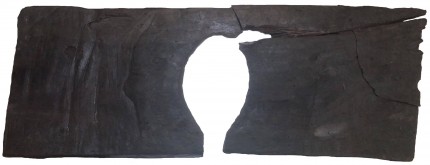 There are many surviving examples of Roman latrines with their characteristic marble bench seating dotted with keyhole-shaped openings. The seats weren’t always stone, however. There were wooden toilet seats as well, but the organic material decays leaving behind only the stone or brick structure. Now archaeologists have unearthed the first Roman toilet seat made of wood perfectly preserved in the waterlogged soil of the Roman fort of Vindolanda.
There are many surviving examples of Roman latrines with their characteristic marble bench seating dotted with keyhole-shaped openings. The seats weren’t always stone, however. There were wooden toilet seats as well, but the organic material decays leaving behind only the stone or brick structure. Now archaeologists have unearthed the first Roman toilet seat made of wood perfectly preserved in the waterlogged soil of the Roman fort of Vindolanda.
Vindolanda, a fort and settlement in Northumberland just south of Hadrian’s Wall, has been an unparalleled source of artifacts illuminating daily life in this remote outpost of the Roman Empire starting with the first timber fort built in the late 1st century (around 85 A.D.). Its anaerobic ground has preserved organic material like letters written on wood, leather sandals and textiles.
 The wooden toilet seat was discovered by Dr. Andrew Birley, director of excavations, in a pre-Hadrianic trash pile from the last fort built on the site before the construction of Hadrian’s Wall in around 122 A.D. That was the fifth timber fort built at Vindolanda after the demolition of the previous one in 105 A.D., so the toilet seat could have been in use for almost two decades.
The wooden toilet seat was discovered by Dr. Andrew Birley, director of excavations, in a pre-Hadrianic trash pile from the last fort built on the site before the construction of Hadrian’s Wall in around 122 A.D. That was the fifth timber fort built at Vindolanda after the demolition of the previous one in 105 A.D., so the toilet seat could have been in use for almost two decades.
That’s a long time for a piece of wood to do such hard duty (yes, I said duty), and there’s no way of knowing how long it was in use, but there is a great deal of wear around the opening. The ass groove, if I may borrow from that great neologist Homer Simpson, indicates the seat was very thoroughly used before being discarded.
Dr Birley commented on the find “there is always great excitement when you find something that has never been seen before and this discovery is wonderful….” Andrew went on to say “We know a lot about Roman toilets from previous excavations at the site and from the wider Roman world which have included many fabulous Roman latrines but never before have we had the pleasure of seeing a surviving and perfectly preserved wooden seat. As soon as we started to uncover it there was no doubt at all on what we had found. It is made from a very well worked piece of wood and looks pretty comfortable. Now we need to find the toilet that went with it as Roman loos are fascinating places to excavate – their drains often contain astonishing artefacts. Let’s face it, if you drop something down a Roman latrine you are unlikely to attempt to fish it out unless you are pretty brave or foolhardy.” Discoveries at Vindolanda from latrines have included a baby boot, coins, a betrothal medallion, and a bronze lamp.

Next on the Vindolanda team’s toilet-related wishlist is a tersorium, a stick topped with a natural sponge that was used to clean the business areas after defecation. This was a communal device, cleaned in a gutter of running water in front of the latrines and left in a bucket of vinegar for the next guy.
The toilet seat will spend the next 18 months being conserved so the wood won’t dry out and become brittle. Once it’s stabilized, it will go on display at the site’s Roman Army Museum where it will doubtless draw crowds because toilets and their uses are endlessly fascinating subjects to humans in every era.
I’m glad to see this history blog is at last getting to the bottom of things.
During harsh pre-Hadrianic wintertimes, to freeze off their mission-critical ‘obsceni militorum’ on cold marble, was apparently not really an option – Habemus Lignum !
Strange fascination, indeed, for all sanitary matters among the public… At least, it makes History and Archaeology even more tangible (these Romans did look a little bit like us, after all)
😆
I have to say, disposable toilet paper is one of the most important modern inventions…
Aand it was in the down position. People wonder why the Empire fell!
Vindolanda is a fascinating site for the archeologically minded. I had a great time wandering around, despite the fact that it was January. (The winds blow downright cold in Northumberland.) Apparently the trust has a new museum at Vindolanda now, but even the smaller museum was stuffed with artifacts rarely seen elsewhere. How often does one find a display case with over 2,000 Roman sandals? Subsurface preservation was good for the perishable artifacts that usually slip away unseen. My favorite are the thin pieces of wood used for writing notes. It took awhile before the excavators realized that the wood slips had writing on them, but what an opportunity for a peek into peoples’ lives. Although upper class women in Italy and environs wrote letters they usually dictated. V. is almost unique in having letters written by Roman women in their own handwriting. Such as invitations to a birthday party. The best one, though, is the young man who wrote to his mother back home asking for more underpants and socks. As I said, it’s cold there in winter.
History bog?
Hmmm?!?!?! I often wonder what it takes to get readers of a blog to jump up and take notice–and even comment… During the 18 month conservation process, will there be testing for residual…um…organic material. Not to mention DNA?
On first reading, I thought sure the good Dr. said, “There is always great excrement when you find something like this.”